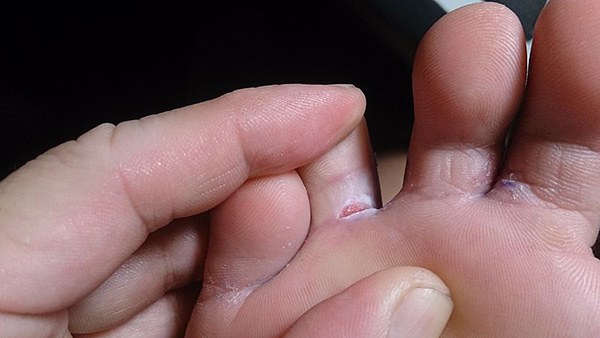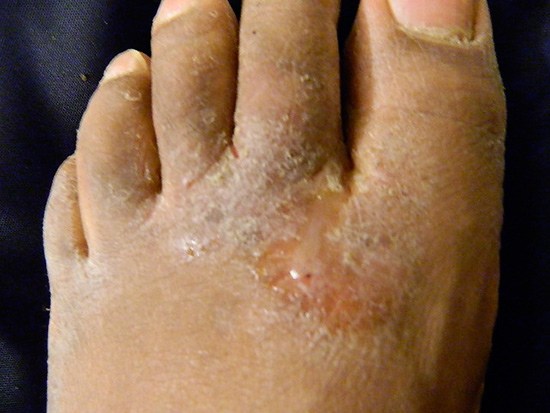If you’re experiencing itching between your toes, chances are that you’re suffering from athlete’s foot, or ‘tinea pedis’ to give it its clinical name.
Athlete’s foot is a common fungal infection – thought to infect around 25% of us – that can be caused by transmission of at least four different kinds of fungus. It is not a serious condition although should be treated promptly to avoid spreading it to other people and to other parts of your own body.
Remember to consult your doctor if you want a specific diagnosis. They will be able to examine your toes to see whether fungus is present, or whether you are experiencing something different.
Symptoms of athlete’s foot

- Itching between your toes – usually starting at the little toes
- A flaky and scaly rash may then develop
- The skin between your toes can split and develop fissures which can be painful
- Painful blisters can develop too
Who gets athlete’s foot?
The fungi that causes athlete’s foot thrives in warm, moist conditions – that means people who get sweaty regularly may well contract it at some point.
It’s a very contagious fungus so anyone who is sharing space or walking barefoot in a space where the athlete’s foot fungus is lurking is also at risk.
Athlete’s foot can afflict anyone but there are a few factors that can put you more at risk of catching it:
- Athletes or those that keep their feet cooped up in warm, sweaty shoes all day
- People that use swimming pools, gyms and communal showers
- People who use nail salons
Types of athlete’s foot
There are four different types of fungus that can cause athlete’s foot although the most common is trichophyton rubrum. These fungi live on hair, nails and skin and are generally passed along the skin.
They can spread to the toenails and hands so be sure to tackle the problem early to limit the spread.
The most common type of athlete’s foot is interdigital – i.e. between the toes.
Another type of athlete’s foot is a moccasin infection. These infections tend to see the skin of the entire sole thickening and perhaps even spreading to the sides of the feet. The skin may crack.
Even rarer is a vesicular infection, which is characterised by a number of blisters appearing on the sole of the foot.

How to cure athlete’s foot
There are a few different methods on the best way to cure athlete’s foot. You may need to try a few things before you find the right cure for you.
Keep an eye on whether any cracks in the skin between your toes have allowed the introduction of a secondary infection into your skin. If you spot any signs of this, remember to consult your doctor so they can tackle your specific problem.
Best antifungal creams for athlete’s foot
Most athlete’s foot cases can be cured with at least one round of topical antifungal cream. These are generally available online, over-the-counter, or even by prescription if necessary.
Antifungal creams tend to be the first option most athlete’s foot sufferers start with and it can prove very effective – particularly on mild to moderate infections.
Here are the best 4 on the market right now:
Clotrimazole Antifungal Cream 1% USP
This is the best-selling medicated antifungal cream in the US right now, containing 1% active ingredient Clotrimazole.
Here are its stand-out features:
- The best priced antifungal cream on Amazon
- Effectively relieves itching, burning, cracking and scaling
- Treats athlete’s foot, jock itch and ringworm
- Comes in a 5-bundle pack – economical and efficient
This is an incredibly popular natural antifungal formula that’s tough on athlete’s foot without any of the harsh chemicals of the medicated creams.
Stand-out features:
- Contains high doses of therapeutic grade Tea Tree, Eucaluptus and Lavender oils (antifungal and antimicrobial)
- Longer lasting stay-on formula that includes beeswax and olive oil
- 180 day money-back guarantee
- No fillers, synthetic chemicals, artificial colours, fragrances, preservatives or detergents
- Made in the USA
REPARA Antifungal Cream Miconazole Nitrate 2%
Another highly popular medicated antifungal cream, containing 2% active ingredient Miconazole Nitrate, that quickly treats and relieves the symptoms of athlete’s foot.
Stand-out features:
- High dose of the active ingredient
- Forms a barrier by repelling moisture and softening the skin while relieving and treating athlete’s foot
- Adheres well to damp skin
- Comes in a large 5oz tube
The Yellow Bird’s All Natural Foot Cream
This is another effective yet natural solution to athlete’s foot that will help your feet get healthy and look great.
Stand-out features:
- Works the whole foot: treats odour, athlete’s foot, psoriasis, cracked heels and calluses
- Contains just 10 natural, organic ingredients including therapeutic grade essential oils
- Free from parabens, phthalates, soy, gluten and GMOs
Home remedies for athlete’s foot
Some people choose to address their athlete’s foot with a series of home remedies – often in conjunction with an antifungal cream in order to speed up the healing process.
Here are a few ideas that you should be able to source easily from home:
- Tea Tree Oil – this is a powerful, natural antifungal that should destroy the fungus and stop it spreading. Add it ‘neat’ in small doses to the fungus or add a few drops to a foot bath and soak.
- Apple Cider Vinegar – vinegar creates an acidic environment in which the fungus cannot survive. Use it in a soak or spray it directly on to the affected area.
- Colloidal Silver – silver supports the immune system in destroying fungi and bacteria. Spray directly onto the athlete’s foot.
- Oregano Oil – this has antifungal, antiseptic and antibacterial properties. Dilute a couple of drops in a teaspoon of coconut oil and apply to the athlete’s foot.
Antifungal pills for athlete’s foot
In the rare cases when neither home remedies or topical creams can provide a cure for your athlete’s foot, your doctor may need to prescribe you antifungal pills to rid you of the infection.
While mostly effective, often these pills have to be taken for a long period of time before a total cure is achieved and can carry some nasty side-effects.
Speak to your doctor about the risks of taking antifungal pills before you embark on a course.
How to prevent athlete’s foot
Like with all medical conditions, prevention is always better than cure when it comes to athlete’s foot.
Follow these recommendations if you want to keep your feet and toes healthy and fungus-free:
- Dry your feet and between your toes thoroughly after getting them wet
- Wear sweat-absorbent socks when you’re wearing shoes all day or playing sports
- Ensure your shoes fit well and aren’t causing any repetitive trauma to your toes
- Wear flip-flops or sandals when using a locker room, communal shower or walking around a swimming pool
- Wash your feet with antifungal wash regularly
- Use an antifungal powder in your shoes
- Don’t share towels, socks or shoes


